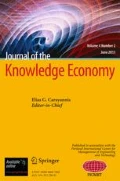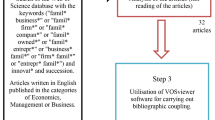Abstract
Standards play an important role in technological diffusion. Empirical evidence shows that standards have a positive influence on innovative potential. Standardization is a key part of microeconomic infrastructure that may serve as a foundation for knowledge and innovation-led growth. In recent years, steps have been taken at different levels toward the development of standardized approaches regarding innovation-related fields of activity, including that of innovation management. The purpose of this paper is a critical review of the European innovation management system developed as a technical specification by the European Committee for Standardization (CEN) in perspective of the Quadruple Innovation Helix model and the Knowledge Triangle concept. Research has a conceptual character. The Quadruple Innovation Helix model and the Knowledge Triangle concept are the point of departure for further deliberations on innovation management standardization. Findings show that although the European innovation management technical specification does not sufficiently address issues stressed in the Quadruple Helix and the Knowledge Triangle approaches, there are some common points: collaboration and creativity. The European innovation management technical specification may be also regarded as a vehicle of transformation ideas and research outcomes into innovation carried out by educated and motivated labor that is consistent with the Knowledge Triangle approach. An improved technical specification of innovation management system (IMS) should incorporate the Knowledge Triangle and the Quadruple Helix approaches to avoid the isolation of a company performing innovation activities.


Similar content being viewed by others
References
Allinson, R., Izsak, K. & Griniece, E. (2012). Catalysing Innovation in the Knowledge Triangle. Practices from the EIT Knowledge and Innovation Communities. EIT.
Arnkil, R., Järvensivu, A., Koski, P. & Piirainen, T. (2010) Exploring Quadruple Helix. Outlining user-oriented innovation models. Työraportteja 85/2010 Working Papers, University of Tampere, Work research Centre.
Ashby, K. & Mahdon, M. (2009). Measuring the nature of demand for innovation in the UK: The challenges of an indicator approach. Working Paper, NESTA, June.
Barandika, G, Bazán, B., Urtiaga M.-K. & Arriortua M.-I. (2014). Design of the Procedure Attached to the Process “Innovation Management” of Eidos, a Materials Science Research Group, and Analysis of its Influence on the Formation of Doctorates. Conference Paper. International Conference the Future of Education, 4th Edition, Conference Proceedings, Florence: Pixel.
Benezech, D. (2012). The open innovation model: some issues regarding its internal consistency. Journal of Innovation Economies, 10(2), 145–165.
Bessant, J. (2003). Challenges in innovation management. In L. V. Shavinina (Ed.), The International Handbook of Innovation (pp. 761–774). Elsevier Science Ltd.
Carayannis, E. G., & Campbell, D. F. J. (2010). Triple helix, quadruple helix and quintuple helix and How Do knowledge, innovation and the environment relate to each other? A proposed framework for a trans-disciplinary analysis of sustainable development and social ecology. International Journal of Social Ecology and Sustainable Development, 1(1), 41–69.
Carayannis, E.G., & Campbell, D.F.J. (2012). Mode 3 Knowledge Production 1 in Quadruple Helix Innovation Systems. 21st-Century Democracy, Innovation, and Entrepreneurship for Development, SpringerBriefs in Business 7, Springer.
Carayannis, E. G., & Campbell, D. F. J. (2014). Developed democracies versus emerging autocracies: arts, democracy, and innovation in quadruple helix innovation systems. Journal of Innovation and Entrepreneurship, 3(12), 1–23.
Carayannis, E. G. & Gonzalez, E. (2003). Creativity and innovation = competitiveness? When, how and why. In L. V. Shavinina (Ed.), The International Handbook of Innovation (pp. 587–606). Elsevier Science Ltd.
CEN (2013). Technical specification part 1: innovation management system, CEN/TS 16555–1.
CEN (2014a). Technical specification part 2: strategic intelligence management, CEN/TS 16555–2.
CEN (2014b). Technical specification part 3: innovation thinking, CEN/TS 16555–3.
CEN (2014c). Technical specification part 5: collaboration management, CEN/TS 16555–5.
CEN (2014d). Technical specification part 6: innovation management assessment, CEN/TS 16555–6.
Chesbrough, H. (2003). Open Innovation: The New Imperative for Creating and Profiting from Technology. Harvard Business School Press.
Council of the EU (2009). Conclusions of the Council and the Representatives of the Governments of the Member States, 14344/09, Brussels, 20 October.
Damaskopoulos, T. (2005). Network topology of the knowledge-driven economy: organizational conditions of knowledge valorization. In P. Formica & J. Stabulnieks (Eds.), Knowledge based entrepreneurship: innovation policy and dynamic development of knowledge driven entrepreneurship. Centro-Ferrara: EffeElle Editori.
DTI (2005, June). The Empirical Economics of Standards. DTI Economics Paper No.12. http://www.sis.se/upload/632555702720125533.pdf. Accessed 23 Nov 2014.
Dubina, I. N., Carayannis, E. G., & Campbell, D. F. J. (2012). Creativity economy and a crisis of the economy? Coevolution of knowledge, innovation, and creativity, and of the knowledge economy and knowledge society. Journal of the Knowledge Economy, 3, 1–24.
Edquist, Ch. (2006). Systems of Innovations: Perspectives and Challenges. In J. Fagerberg, D. C. Mowery, R. R. Nelson (Eds.), The Oxford Handbook of Innovation (pp. 181–208). Oxford University Press.
Etzkowitz, H., & Leydesdorff, L. (2000). The dynamics of innovation: from national systems and “mode 2” to a triple helix of university–industry–government relations. Research Policy, 29, 109–123.
European Commission. (2004a). Innovation management and the knowledge-driven economy. Brussels: European Commission Directorate-General for Enterprise.
European Commission (2004b). The Europe of Knowledge 2020: A Vision for University - Based Research and Innovation. Conference Proceedings. Liège, Belgium, April 25–28.
European Commission (2007). A lead market initiative for Europe. COM (2007) 860 final.
Florida, R. (2003). The rise of the creative class and how it’s transforming work, leisure, community and everyday life. Christchurch: Hazard press.
Hadjimanolis, A. (2003). The Barriers Approach to Innovation. In L. V. Shavinina (Ed.), The International Handbook of Innovation (pp. 559–573). Elsevier Science Ltd.
Hafkesbrink, J., & Schroll, M. (2011). Innovation 3.0: embedding into community knowledge-collaborative organizational learning beyond open innovation. Journal of Innovation Economies, 7, 55–92.
Harris, M. & Albury, D. (2009). Why radical innovation is needed to reinvent public services for the recessions and beyond. The innovation imperative. The LAB Discussion Paper, London: NESTA.
Hemlin, S., Allwood, C.M. & Martin, B. R. (2004). Creative Knowledge Environments. The Influences on Creativity in Research and innovation. Edward Elgar.
Hervás Soriano, F. & Mulatero, F. (2009) Connecting the Dots. How to Strengthen the EU Knowledge Economy. Joint Research Centre – Institute for Prospective Technological Studies, European Communities.
Hobcraft, P. (2012). Preparing Ourselves for Innovation Standards. http://www.innovationmanagement.se/2012/11/22/preparing-ourselves-for-innovation-standards/. Accessed 20 Jan 2015.
Howaldt, J. & Schwartz, M. (2010). Social innovation: concepts, research fields and international trends. Studies for Innovation in a Modern Working Environment-International Monitoring, Volume 5, Aachen: IMA/ZLW&IfU.
Igartua, J. I., Garrigós, J. A. & Hervas-Oliver, J. L. (2010). How innovation management techniques support an open innovation strategy. Research - Technology Management, May –June, 41–52.
Katz, R. (2003). Managing Technological Innovation in Business Organizations, In L. V. Shavinina (Ed.), The International Handbook of Innovation (pp. 775–789). Elsevier Science Ltd.
King, A. A., Lenox, M. J., & Terlaak, A. (2005). The strategic use of decentralized institutions: exploring certification with the ISO 14001 management standard. Academy of Management Journal, 48(6), 1091–1106.
Maier, A., Brad, S., Fulea, M., Nicoară, D., & Maier, D. (2012). A proposed innovation management system framework—a solution for organizations aimed for obtaining performance. World Academy of Science, Engineering and Technology, 6, 1678–1682.
Mir, M., & Casadesús, M. (2011). Standardised innovation management systems: a case study of the Spanish standard UNE 166002: 2006. INNOVAR, 21(4), 171–187.
Moos, B., Beimborn, D., Wagner, H.-T., & Weitzel, T. (2013). The role of knowledge management systems for innovation: an absorptive capacity perspective. International Journal of Innovation Management, 17(5), 1350019–1–1350019–31.
Nayyar, P. R. (1990). Information asymmetries: a source of competitive advantage for diversified service firms. Strategic Management Journal, 11(7), 513–519.
OECD (1999, January). Regulatory Reform And International Standardisation. TD/TC/WP(98)36/FINAL.
Owen, R., Stilgoe, J., Macnaghten, Ph., Gorman, M., Fisher, E. & Guston, D. (2013). A framework for responsible innovation, In R. Owen, J. Bessant & M. Heintz, Responsible Innovation (pp.27–50). Wiley.
Peetri M. (2013). The importance of an innovation management system. Master Thesis Dissertation. Faculdade de Engenharia da Universidade do Porto. https://www.google.pl/url?sa=t&rct=j&q=&esrc=s&source=web&cd=1&ved=0CCIQFjAAahUKEwiUhvSi357HAhWJ7BQKHXTkC8s&url=http%3A%2F%2Fsigarra.up.pt%2Ffeup%2Fpt%2Fpubls_pesquisa.show_publ_file%3Fpct_gdoc_id%3D347216&ei=p7fIVdSWNInZU_TIr9gM&usg=AFQjCNGANVG1ZLaG16qgrN4JUw173XXKUQ&bvm=bv.99804247,d.ZGU&cad=rja.
Pellicer, E., Yepes, V., Correa, C., & Martines, G. (2008). Enhancing R&D&i through standardization and certification: the case of the Spanish construction industry. Revista Ingenieria de Construcción, 23(2), 112–121.
Pop, O.-M. (2012). Systematic Innovation and the Journey Towards a Unified Innovation Management Standard. http://www.innovationmanagement.se/2012/11/19/systematic-innovation-and-the-journey-towards-a-unified-innovationmanagement-standard/. Accessed 5 April 2015.
Reinmoeller, P. & van Baardwijk, N. (2005). The link between diversity and resilience, MIT Sloan Management Review, July, http://sloanreview.mit.edu/article/the-link-between-diversity-and-resilience/. Accessed 20 Feb 2015.
Sanetra, C. & Marbán, R. M. (2007). The Answer To The Global Quality Challenge: A National Quality Infrastructure. Organization of American States. Physikalisch-Technische Bundesanstalt, Sistema Interamericano de Metrología.
Tarnawska, K., & Ćwiklicki, M. (2012). Evaluation of the European social fund as a measure to support social innovation in the public sector. Economics and Management, 17(1), 237–243.
Terlaak, A., & King, A. A. (2006). The effect of certification with the ISO 9000 quality management standard: a signalling approach. Journal of Economic Behavior & Organization, 60, 579–602.
Vachhrajani, H. (2008). A symbiosis of quality and innovation: creating an integrated model for SMEs, quality—striving for excellence. National Centre for Quality Management, 6(5), 2–5.
von Hippel, E. (2005). Democratizing innovation. Cambridge, Massachusetts, London, England: The MIT Press.
Wright, C., Sturdy, A., & Wylie, N. (2012). Management innovation through standardization: consultants as standardizers of organizational practice. Research Policy, 41, 652–662.
Zhou, J. & Woodman, R. W. (2003). Managers’ recognition of employees’ creative ideas: a social-cognitive model. In L. V. Shavinina (Ed.), The International Handbook of Innovation (pp. 631–640). Elsevier Science Ltd.
Author information
Authors and Affiliations
Corresponding author
Rights and permissions
About this article
Cite this article
Mavroeidis, V., Tarnawska, K. Toward a New Innovation Management Standard. Incorporation of the Knowledge Triangle Concept and Quadruple Innovation Helix Model into Innovation Management Standard. J Knowl Econ 8, 653–671 (2017). https://doi.org/10.1007/s13132-016-0414-4
Received:
Accepted:
Published:
Issue Date:
DOI: https://doi.org/10.1007/s13132-016-0414-4




